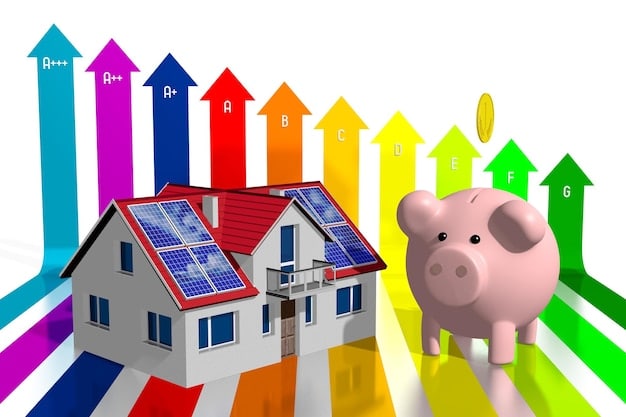Solar Battery Storage in 2025: Is It a Worthwhile Investment?

Battery storage for solar is transforming energy management, but in 2025, evaluating its financial sense involves considering factors such as decreasing battery costs, government incentives, and the potential for energy independence and grid resilience, which might make the investment worthwhile for long-term savings and sustainability.
Is investing in battery storage for solar: Is it worth the investment in 2025? A financial breakdown on your radar for 2025? As solar energy becomes more mainstream, integrating battery storage solutions is increasingly relevant for homeowners and businesses alike.
Understanding the Basics of Solar Battery Storage
Solar battery storage allows you to store excess energy produced by your solar panels for later use. This is particularly useful during periods when solar panels aren’t generating electricity, such as at night or on cloudy days. But how does it all work, and what are the components involved?
How Solar Battery Systems Work
Solar battery systems work by storing surplus electricity generated by solar panels. When the panels produce more energy than you need, the excess goes into the battery. This stored energy can then be used to power your home or business when the solar panels aren’t producing enough electricity. The system automatically switches between solar, battery, and grid power to optimize energy use and savings.
Key Components of a Solar Battery System
A typical solar battery system includes solar panels, a battery, an inverter, and a monitoring system. The solar panels convert sunlight into electricity, which is then sent to the inverter. The inverter converts the DC electricity from the panels into AC electricity that can be used by your home or stored in the battery. The monitoring system allows you to track your energy production and usage, ensuring everything is running smoothly. The battery itself is crucial, and understanding its capacity and lifespan is essential for evaluating the system’s overall value.
- Solar Panels: Capture sunlight and convert it into electricity.
- Battery: Stores excess electricity for later use.
- Inverter: Converts DC electricity to AC electricity.
- Monitoring System: Tracks energy production and usage.
In summary, solar battery storage systems capture, store, and redistribute energy, ensuring you can utilize the clean power generated by your solar panels even when the sun isn’t shining. Understanding these basics is crucial for evaluating the financial viability of investing in such a system.
The Financial Benefits of Solar Battery Storage in 2025
Investing in solar battery storage can offer substantial financial benefits. These benefits range from reducing your electricity bills to taking advantage of government incentives and increasing your energy independence. Let’s dive into the specifics of how you can save money with solar battery storage.
Reduced Electricity Bills
One of the primary financial benefits of solar battery storage is the reduction in your electricity bills. By storing excess solar energy and using it during peak hours or when solar panels aren’t producing, you can significantly decrease your reliance on grid electricity. This is especially advantageous in areas with high electricity rates.
Government Incentives and Rebates
Many governments offer incentives and rebates to encourage the adoption of solar and battery storage systems. These incentives can significantly reduce the upfront cost of your investment. Be sure to research federal, state, and local programs to see what’s available in your area. The Investment Tax Credit (ITC), for example, can cover a significant portion of the installation costs.
- Federal Tax Credits: Reduce your federal tax liability by a percentage of the system cost.
- State Rebates: Offer direct financial incentives for installing solar and battery storage.
- Local Programs: Provide additional rebates or tax credits specific to your city or county.
In essence, the financial benefits of solar battery storage stem from lower electricity bills and various government incentives. By understanding and leveraging these advantages, you can make a more informed decision about whether this investment is right for you. This will depend on your consumption and solar setup.

The Costs Associated with Solar Battery Storage
While solar battery storage offers numerous benefits, it’s important to consider the associated costs too. These costs include the initial investment, installation fees, maintenance expenses, and potential replacement costs. Understanding these factors can help you determine if the investment is financially feasible.
Initial Investment and Installation Costs
The initial investment for a solar battery storage system includes the cost of the battery, inverter, and other components, as well as the installation fees. Battery prices can vary depending on the capacity, technology, and brand. Installation costs typically involve electrical work, permitting, and labor.
Maintenance and Replacement Costs
Solar batteries require ongoing maintenance to ensure optimal performance. This may include regular inspections, cleaning, and software updates. Additionally, batteries have a limited lifespan and will eventually need to be replaced. The cost of replacement can be significant, so it’s essential to factor this into your long-term financial planning.
Factors Affecting the Overall Cost
Several factors can affect the overall cost of solar battery storage. These include the size of the battery, the complexity of the installation, and the location of your home or business. Additionally, the type of battery technology (e.g., lithium-ion, lead-acid) can also impact the price. Researching different options and obtaining multiple quotes can help you find the best value.
- Battery Size: Larger batteries cost more but offer more storage capacity.
- Installation Complexity: Difficult installations can increase labor costs.
- Battery Technology: Different technologies have varying costs and lifespans.
Solar battery storage involves various costs beyond the initial purchase price. By carefully considering these expenses, you can make a well-informed decision that aligns with your financial goals. This includes performing consistent and rigorous maintenance for the hardware.
Long-Term Savings and ROI of Solar Battery Storage
Evaluating the long-term savings and Return on Investment (ROI) of solar battery storage is critical for determining its financial viability. This involves assessing factors such as energy savings, the lifespan of the battery, and the potential for increased property value.
Calculating Energy Savings Over Time
To calculate the energy savings over time, you need to estimate how much electricity you’ll save by using battery storage instead of grid power. This depends on your energy consumption patterns, the size of your solar panel system, and the capacity of your battery. By tracking your energy usage and solar production, you can get a more accurate estimate of your potential savings.
Lifespan and Degradation of Batteries
Batteries degrade over time, meaning their storage capacity decreases with each charge and discharge cycle. Understanding the lifespan and degradation rate of your battery is essential for projecting long-term savings. Most batteries come with a warranty that guarantees a certain level of performance over a specific period.

Impact on Property Value
Installing a solar battery storage system can increase the value of your property. Many homebuyers are willing to pay a premium for homes with renewable energy systems, as it can save them money on electricity bills and reduce their carbon footprint. This can make your home more attractive to potential buyers if you ever decide to sell.
- Increased Home Appeal: Renewable energy systems attract eco-conscious buyers.
- Higher Resale Value: Homes with solar and battery storage can command a higher price.
- Long-Term Investment: Adds value to your property in addition to energy savings.
In conclusion, solar battery storage can provide significant long-term savings and a positive ROI. This is only properly calculated if you consider factors such as energy savings, battery lifespan, and the potential impact on property value. This ultimately maximizes energy efficiency.
Factors to Consider Before Investing in 2025
Before investing in solar battery storage in 2025, consider several crucial factors. These include assessing your energy needs, evaluating available battery technologies, understanding local regulations, and considering environmental impacts. A thorough evaluation ensures that your investment aligns with your goals and circumstances.
Assessing Your Energy Needs
Start by evaluating your energy needs. How much electricity do you typically use each day? When do you use the most energy? Understanding your energy consumption patterns can help you determine the size and type of battery storage system that’s right for you. A larger battery may be necessary if you have high energy demands, while a smaller battery may suffice if you primarily want backup power.
Evaluating Different Battery Technologies
There are several different battery technologies available, each with its own advantages and disadvantages. Lithium-ion batteries are the most common choice due to their high energy density and long lifespan. However, other options such as lead-acid and flow batteries may be more suitable for certain applications. Researching the different technologies can help you make an informed decision.
Understanding Local Regulations and Permits
Local regulations can significantly impact your ability to install and operate a solar battery storage system. Some areas may have restrictions on the size or type of battery you can use, while others may require specific permits or inspections. Contacting your local authorities can help you understand the requirements in your area.
Investing in solar battery storage requires considering your energy needs, battery technologies, and local regulations. A thorough assessment ensures that your investment aligns with your goals and local context.
Future Trends in Solar Battery Storage
The future of solar battery storage is ripe with innovation and growth. Advancements in battery technology, declining costs, and increased adoption rates are paving the way for a more sustainable energy landscape. Keeping an eye on these trends can help you make forward-looking investment decisions.
Advancements in Battery Technology
Battery technology is constantly evolving, with researchers developing new materials and designs that offer higher energy density, longer lifespans, and improved safety. Solid-state batteries, for example, are expected to offer significant improvements over traditional lithium-ion batteries. These advancements could make solar battery storage even more efficient and cost-effective in the future.
Decreasing Costs and Increased Adoption
The cost of solar battery storage has been declining steadily in recent years, and this trend is expected to continue. As battery prices fall, more homeowners and businesses will be able to afford these systems, leading to increased adoption rates. This increased demand will further drive down costs, creating a positive feedback loop.
- Economies of Scale: Increased production and demand drive down costs.
- Technological Innovation: New materials and designs improve efficiency and reduce prices.
- Government Support: Incentives and policies promote adoption and innovation.
Future trends in solar battery storage point towards greater efficiency, lower costs, and increased accessibility. Staying informed about these developments can help you make strategic decisions.
| Key Point | Brief Description |
|---|---|
| 💰 Cost Savings | Reduce electricity bills by using stored solar energy. |
| ⚡ Energy Independence | Store solar energy for use during power outages. |
| 🌎 Environmental Impact | Reduce dependency on fossil fuels. |
| 📈 ROI Potential | Long-term savings and increased property value. |
FAQ
▼
Most solar batteries last between 5 to 15 years, depending on the technology and usage. Lithium-ion batteries typically have longer lifespans, ranging from 10 to 15 years, while lead-acid batteries may last 5 to 7 years.
▼
The cost to install a solar battery system can range from $7,000 to $20,000, depending on the size of the battery, the complexity of the installation, and any available incentives or rebates. It’s best to get multiple quotes.
▼
Yes, with a sufficiently sized battery system and solar panel array, you can power your entire home. However, it’s important to calculate your energy needs to ensure the system is capable of meeting your electricity demands.
▼
Energy independence reduces reliance on the grid, providing power during outages and potentially lowering utility bills. It also mitigates risks from rate hikes and supports environmental sustainability efforts by using renewable energy.
▼
Government incentives, such as tax credits and rebates, can significantly reduce the upfront cost of solar battery storage. These incentives make it easier for homeowners and businesses to afford renewable energy solutions.
Conclusion
In 2025, determining whether battery storage for solar: Is it worth the investment in 2025? A financial breakdown hinges on a combination of factors, including individual energy needs, available incentives, and long-term financial goals. By carefully evaluating these aspects, you can make an informed decision that positions you for energy independence and financial savings.





